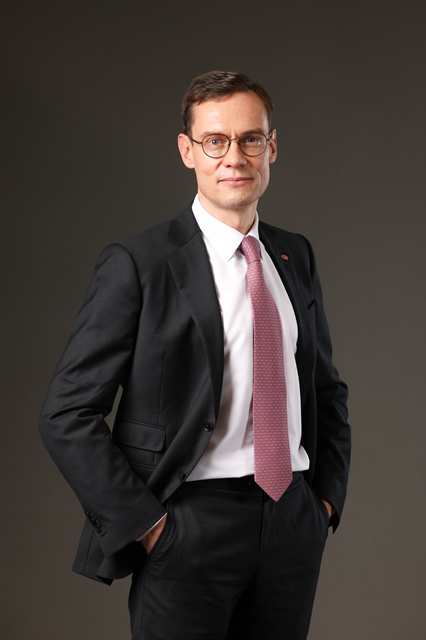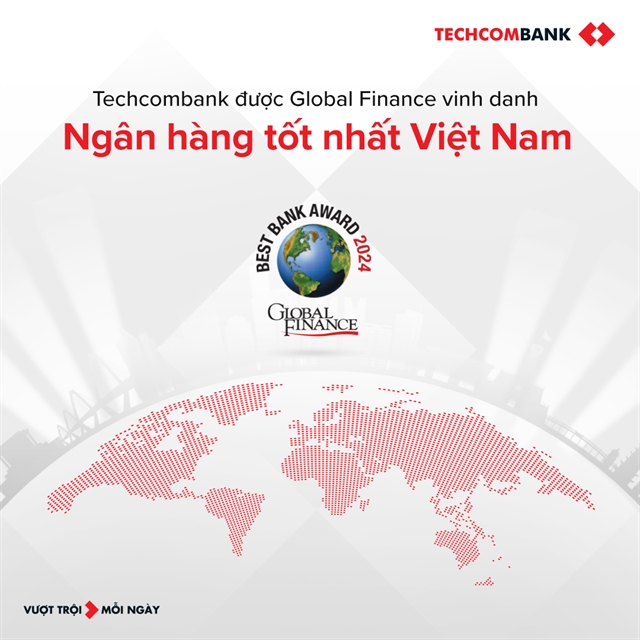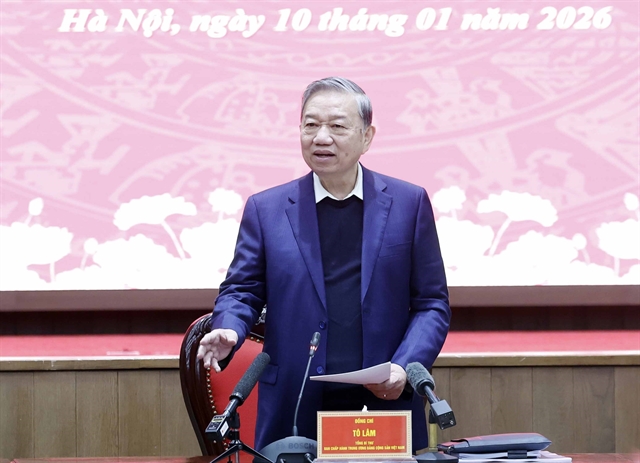 Economy
Economy

 |
| Alex Macaire, CFO of Techcombank. — Photo courtesy of the bank |
Despite a challenging year, Techcombank finished 2023 strongly thanks to product innovation and nimble financial execution. In an exclusive interview, Alex Macaire, CFO of Techcombank, shares insights into the bank’s strategic direction, financial performance, and future prospects.
Techcombank’s growth in total assets is projected to reach an impressive US$41 billion in 2024. How did the bank achieve this milestone, especially considering the challenges faced in 2023 across both assets and liabilities?
As you said, 2023 was a challenging year. However, if we look at our business results for the year, we can see a strong turnaround, thanks to the robustness of our business model and our ability to predict and promptly adjust to market developments.
Techcombank’s portfolio saw steady growth throughout 2023, with the bank’s total profitable assets increasing by 23 per cent over the year.
In the first half of the year, credit growth mainly came from corporate customers, then gradually shifted to the retail segment. This trend was consistent with the recovery of the retail real estate market as the year went on.
While this was an impressive result, our financial goals are more comprehensive than just the size of our balance sheet and we were pleased to see upward momentum in most performance metrics.
This enabled us to achieve strong profitability and maintain our number one position in terms of average return on assets (ROA) in the entire market over the past five years.
Regarding the bank’s revenue, we saw robust growth from service fees. Fee income is one of Techcombank's top priorities because it helps us diversify revenue and improve capital efficiency.
Techcombank is proud to be the number one bank in Việt Nam in terms of fee income. In those areas of ROA and fee generation, perhaps our biggest challenge now is to compete with ourselves to reach new heights.
 |
| Techcombank was named ‘Best Bank in Việt Nam 2023’ by US-based financial publication Global Finance. — Photo courtesy of the bank |
Our strong financial performance, despite economic headwinds, is one of the reasons why Techcombank was named ‘Best Bank in Việt Nam 2023’ by US-based financial publication Global Finance. This award takes into account many criteria, such as financial and operational performance, customer offerings and experiences, technological innovation, and environmental and social impact.
A number of observators, both in Việt Nam and overseas, see Techcombank as a leading banks in its market, and a regional champion in the making.
 |
| Transactions at Techcombank. — Photo courtesy of the bank |
Techcombank is witnessing a transition from corporate loans to consumer loans. Will this be a key direction for the bank going forward into the coming year?
Our long-term strategy is indeed to shift towards retail customer lending to help further diversify our credit exposure, enhance our risk profile, and improve our capital efficiency.
In 2023 we saw stronger demand for corporate lending activities, compared to retail and this did slow our credit diversification. However, as I mentioned, within our corporate credit book, non-real estate-related lending grew over 60 per cent in 2023 compared to 2022 and we began to see a recovery in retail lending from the second half of 2023.
Techcombank applies a value chain approach to its lending activities. For example, in the real estate sector, Techcombank provides loans to investors to develop residential projects. When the projects are implemented, credit will flow to construction contractors, material suppliers, and finally to home buyers. Cash flow circulates in our ecosystem and risks are spread across a diverse customer base in the value chain.
This is how we mitigate credit risk and shift our exposures from corporate to retail customers, diversifying the bank’s loan portfolio. Our value-chain approach has established Techcombank as a leader in this successful model, in addition to helping us acquire over the years one of the most valuable retail customer bases in the entire market.
You mentioned the utilisation of the value chain model to broaden the retail sector, mirroring the success seen earlier with real estate chain financing. Could you elaborate on this?
Indeed, as I’ve emphasised, the creation of deep, strong partnerships and high professional expertise in funding value chains for high-profile projects in Việt Nam is a key strength and an 'invaluable asset' that Techcombank has accumulated over decades. The bank is now looking to replicate the same approach in other sectors, beyond real estate and construction. This includes industries such as fast-moving consumer goods, utilities, automotive, finance, insurance, travel and entertainment. We’ll start by crafting business models with key partners, gradually expanding to contractors, network suppliers, and ultimately consumers.
A good example of this strategy is the “WinLife” partnership with Masan, where Techcombank’s innovative payment solutions and superior reward schemes are made available through more than 3,600 Winmart convenience stores across the country. In each sector, the objective is to leverage the bank’s unique relationship with one or more “anchor” customers, and from there, develop a comprehensive set of transaction, credit and investment solutions catering to the needs of the various actors in the value chain, starting from the suppliers down to the final consumers.
Being able to deploy this deep value-chain expertise to access the best customers is an important differentiating value in the market. It has helped Techcombank achieve near zero credit defaults in its wholesale banking division, and build an unparalleled franchise in the high net-worth and affluent segments, establishing banking relationships with more than 50 per cent of customers in those segments. It creates a trust-based partnership between the bank and all the actors in the value chain, reducing risk and creating opportunities for all the participants.
 |
| dsfs |
Techcombank’s CASA ratio rebounded significantly in 2023, nearing 40 per cent. However, that’s still quite a distance from the 55 per cent target set for the 2021-25 transformation journey. What’s your take on this?
Our goal this year is to continue to grow our CASA balance and sustainably increase our CASA ratio, building on the strong momentum we have seen in the latter half of 2023.
One of Techcombank’s key strategic objectives is to lead in CASA ratio, and we remain 100 per cent focused on achieving a 55 per cent CASA ratio by 2025. With an abundant and stable CASA base, Techcombank has emerged as one of the industry leaders in profit margin. The significant CASA volume not only lowers our cost of capital but also enables us to offer competitive loan rates. In addition, our success in the transformation journey over the past four years stems from our ability to compete with Việt Nam’s state-owned banks in terms of pricing and interest rate policies. Achieving a high CASA ratio is therefore integral to realising our cost-effective capital strategies and driving business growth.
Could you elaborate on the bank's plans to "close the gap" in the CASA 2024 target?
Based on experience, banks’ CASA balances typically experience a slight decline in the early months of the year, reflecting the consumption and investment patterns of both individuals and businesses as they enter a new business cycle. However, CASA growth typically resumes in subsequent quarters.
Several factors should help us get closer to our long-term CASA target in 2024.
The first one is the continuous progress we are making in our payment and transaction services. Techcombank is the leader in credit cards in Việt Nam, with more than 20 per cent market share on all Visa payments. Our Digital transaction volumes increased by 57 per cent between the first and the last month of 2023. We have also made significant strides with our corporate payment solutions, including reverse factoring, dynamic discounting and distributor financing. As a result, the CASA balances from our corporate customers increased by 59 per cent in 2023, accounting now for over 40 per cent of our total CASA base. Our payment leadership therefore provides the foundation for our CASA momentum.
Besides, a second important driver is the strength of our wealth franchise. Techcombank is a leader in the bond and equity markets, and as our customers become more pro-risk and return to these products, they need to keep higher CASA balances to fund their investments, which benefits the bank.
Last but not least, in January 2024, Techcombank spearheaded innovation in the banking industry with the launch of a breakthrough product called Auto-Earning. It is designed to help customers optimise their idle cash and earn attractive interest rates. The key differentiators of Auto Earning are convenience and time-saving benefits, as it is readily available on the Techcombank Mobile app and can be easily activated with a simple touch. Therefore, Auto Earning is expected to offer great assistance to customers in their financial journey, thereby deepening banking relationships and helping to increase the Bank’s customer base and CASA balance.
Techcombank has garnered attention with reports of its intention to distribute cash dividends for the first time in a decade. Could you elaborate on this?
10 years ago, the bank decided to retain all profits to reinvest and expand business operations, while maintaining a high capital adequacy ratio (CAR). The objective was to be able to self-fund a stable and elevated growth rate of at least 20 per cent a year.
In the past 10 years, Techcombank has gone through quite an interesting journey. Whether in difficult or favorable market environments, we strived to promote our leading position in terms of digital transformation and effectiveness of business operations. After a decade of growing profits at a rate of nearly 40 per cent per year, Techcombank has established itself as the leading private bank in Việt Nam, delivering a cumulated pre-tax income in excess of $3 billion over the last three years.
The fact that we have been able to maintain a strong profit generation capacity even in adverse environments was an important factor in our decision to start paying dividends. We acquired the confidence that we would be able to continue a business growth momentum above the industry average while keeping a Core Equity Tier 1 capital adequacy ratio of 14-15 per cent. With the perspective of sustainable business and profit growth, the bank's Board of Directors has confidently proposed to start paying cash dividend from 2024 for shareholders to approve in the upcoming General Meeting of Shareholders on April 20th.
Would paying dividends in cash affect Techcombank's top position in terms of capital adequacy ratio (CAR)?
This is a very good question. Given Techcombank’s solid capital foundations and the strategic initiatives being implemented, I believe that paying cash dividends will not adversely affect the CAR ratio or any other financial indicators of Techcombank. The bank will continue to maintain its growth momentum. Techcombank's story essentially reflects the inspiring journey of Việt Nam's development. The dividend plan has been carefully considered by our Board of Directors, which has agreed that it will bring outstanding value to our shareholders, in line with our objective to offer a unique and differentiated value proposition. By investing into Techcombank’s stock, shareholders have the possibility to directly participate in a stream of income linked to the bank’s financial performance, while retaining all the potential for upside coming from Techcombank’s unique positioning in Việt Nam’s and regional market.
What is the bank's CAR target for this year?
We will maintain our CAR ratio from about 14-15 per cent.




